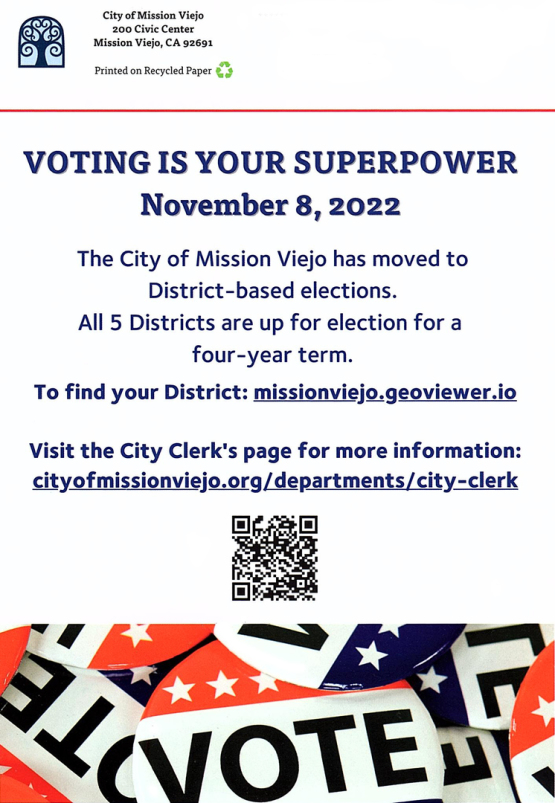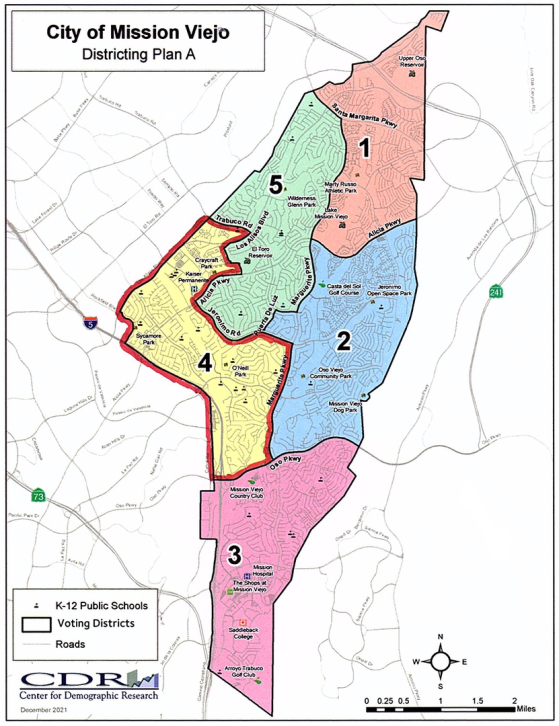
Truth detector -- disspelling the rumors
In response to the lawsuit by a resident against the City and the judge's preliminary order to require all five City Council seats to be on the ballot in November, I read the following statement at the July 12th City Council meeting. --Trish
"For the past several months, the Mission Viejo City Council has been criticized by a handful of individuals who have come to every meeting to raise their voices in objection to Trish Kelley and Brian Goodell running in 2024. Because one of these individuals filed a lawsuit against the City, the City Attorney advised us not to respond to their allegations at the past few meetings. But now that the issue has been adjudicated, we can speak. I want to assure the public that the City Council at all times has acted in good faith, and has followed the stipulated judgment and the City’s municipal code in our plan to have Districts 2 (Goodell) and District 4 (Kelley) run in 2024. I was quite surprised by the judge’s preliminary order, which requires Districts 2 and 4 to run for election this year. As a background, when Mission Viejo was sued for “racially polarized voting,” allegedly caused by our “at large” voting system, our City did not immediately move to District elections as many other cities did. For Mission Viejo, that “solution” does not solve the perceived problem, because there is no way to draw a district that has a majority of Hispanic voters. Our city is diverse and we have many ethnicities homogenized evenly throughout Mission Viejo.
“Since district elections would not provide a solution, and because many of our residents were justifiably opposed to district elections, we looked at other voting systems, such as cumulative voting, that would give the minorities a greater voice and would be more in line with our residents’ wishes. Both sides of the lawsuit — and the judge himself — agreed that cumulative voting would provide the greatest voice to the minorities dispersed throughout our City, so we pursued cumulative voting. In order to work, cumulative voting would require that all five council members run at the same time, due to the math involved for this system. Based on our mutual desire to use a cumulative voting system, our attorney and the plaintiff’s attorney wrote a stipulated judgment, which stated, “Unless the city adopts district-based voting at some later date, all elections for the city’s governing board (Mission Viejo City Council) shall employ cumulative voting…” As noted, cumulative voting would require all five council members to run at the same time. We tried for three years to convince the California Secretary of State to authorize cumulative voting or ranked choice voting in Mission Viejo. Two different Secretaries of State, Alex Padilla and Shirley Weber, rejected these election options, so we were forced to revert to district-based elections for the 2022 election. In reverting to district-based voting, we fell back onto our City Municipal Code, which specifies 4-year terms. We have stated many times that the 2-year terms would only apply if we went to cumulative voting. We assumed that since this was the same Judge who had approved and signed the stipulated judgment with the wording “unless city adopts district-based voting,” that he would remember this crucial phrase and rule in our favor. He had even made hand-written notes on that document. But in his preliminary order, he ruled otherwise, ignoring his own prior language, and has ordered Districts 2 and 4 to run this year instead of 2024.
“Your City Council Members have been under attack for the past several months, with many hateful comments and accusations. When I look at the accomplishments of this Council, the only explanation I can see for these constant attacks is that it is an election year. I want to remind our residents of the good work this council has done, by just sharing a few highlights. We are continually ranked as one of the safest cities in the state and in the nation. We have had balanced budgets every year. Last year, 24/7 Wall Street named Mission Viejo as the best city in California in which to live, confirming that our quality of life here is wonderful! In addition, Money Magazine recently named Mission Viejo as one of the 50 best cities in which to live in America! We have weathered the pandemic and the economic fallout by reducing our costs and increasing efficiencies, and our last budget update shows that we have reserves of $32.4 million, which is 47.6% of our general fund revenues. We preserved 110 acres of open space and a beloved golf course by purchasing the Oso Creek Golf Course (formerly Casta del Sol Golf Course) with cash, improving it with revenue generated by the golfers, and fully recovering the cash price that we paid for it. We are making progress on our City’s vision plan to enhance the civic core, and have launched a new website to provide information: https://envisionmv.com. Our last community satisfaction survey showed that 94% of our residents rated our quality of life as excellent or good. These results do not happen by accident, but are accomplished through the leadership provided by the City Council.
“Again, I was surprised by the preliminary order of the judge to require Districts 2 and 4 to be on the ballot. Although the matter is still pending before the courts, the City Council took pre-emptive action to move forward to put District 2 and 4 on the ballot in November, in order to prevent confusion and to prepare for the 2022 election. All five City Council seats will be on the ballot for 4-year terms in November.”
The following City of Mission Viejo announcements are reprinted here as a convenience to web site viewers and provides clarifying information and amplification of my original statements (below) regarding changes in Mission Viejo council elections. -- Trish
CITY COUNCIL ESTABLISHES VOTING PROCESS FOR 2022 GENERAL ELECTION, ALL FIVE COUNCIL DISTRICTS ARE UP FOR ELECTION
Date: July 12, 2022
The Mission Viejo City Council on Tuesday, July 12 established the voting process for the upcoming general election on November 8. As a result, all five newly established City Council districts will be up for election for four-year terms.
While this matter is essentially still pending before the courts and wouldn’t have reached a final resolution for months, the City Council, which voted 5-0 in favor of the motion, took preemptive action to prevent confusion and uncertainty heading into the general election, particularly for voters and potential candidates, and to accommodate recent requests from the Registrar of Voters to achieve certainty for ballots and campaign materials.
“We proactively establish… that all five districts be up for election,” said Mayor Wendy Bucknum. “We run our City in a smart, efficient and common sense manner.”
The City of Mission Viejo previously reached a stipulated judgment with the Southwest Voter Registration Education Project to change its voting system. The City has diligently worked in good faith to lawfully comply with those stipulations, including the implementation of district-based voting to ensure appropriate representation for all Mission Viejo residents. Tuesday’s actions further this important goal.
Click this link to view a PDF of the five Mission Viejo voting districts:
https://cityofmissionviejo.org/sites/default/files/PLAN_A_packet_MV2022.pdf
Date: July 15, 2021
After more than three years working toward a cumulative voting system to benefit minority voters, the Mission Viejo City Council will move to a district-based election system beginning in November 2022.
District-based voting would carve the City up into geographic districts, which would each be represented on the City Council by someone who lives there. The decision to move to this voting system comes after exhausting all efforts to ensure the best outcome for this community. It was sparked by a 2018 lawsuit claiming the City’s at-large election system dilutes the vote of the Latino community. While many cities immediately adopted district voting without a challenge, the Mission Viejo City Council took proactive community-oriented steps to see if a violation did exist and – if so – how to remedy it.
Mission Viejo’s demographics were first analyzed to determine if the at-large voting system truly produced voting results that violated the California Voting Rights Act – and it did. The Council then worked to determine which voting structures used across the nation would give a “real” voice to minority voters rather than immediately moving to less beneficial district-based voting.
Since minority residents live throughout the City, as opposed to one specific area, district voting does not remedy the issue of racial discrimination in the at-large voting system.
In addition, the Council pursued statutory interpretations recommended and supported by the minority voters to give the best voice to the vote cast by minority voters.
However, despite the Council’s extraordinary efforts on behalf of this community, the State will not allow the cumulative voting method in Mission Viejo or another City absent legislative action in Sacramento.
“The California Voting Rights Act allows judicially approved alternatives to district-based voting,” said Council member Greg Raths, who serves on the Voting Rights Subcommittee with Mayor Trish Kelley, in a joint statement. “The worthy alternative includes cumulative or rank-choice voting. However, these options for change are seemingly too significant for State staff to authorize. Thus, as Sacramento will not allow rank-choice voting or cumulative voting to best serve our minority residents, we must now defer to the one-size-fits-all district voting remedy. It is unfortunate that the best interest of our minority voters cannot be served, but your City Council worked very hard to achieve a system that would give them a greater voice. We had sincerely hoped for a better outcome for Mission Viejo minority voters, but Sacramento is not allowing any option other than district voting absent expensive legislative and legal efforts.”
The City Council meets next on August 24 and will provide a comprehensive report.
“We have actively been pursuing what we had hoped to be in the best interests of our community,” said Mayor Trish Kelley. “We do now have a plan and will be returning in August to discuss district maps and what the process will be and how residents can get involved.”
Clarifying the 2020 Election Confusion
I received a number of emails and phone calls after the Voice of OC published an article full of misinformation which also resulted in players on Facebook perpetrating the misinformation. What follows is my response to an upset constituent:
Dear xxxxxxxx,
Thank you for taking the time to share your thoughts and concerns about the upcoming Mission Viejo election. I would like to give you some information since we are hearing from a number of residents who are concerned due to the Voice of OC article and because of some misinformation of individuals on Facebook and through emails. Some of the information in the Voice of OC article is incorrect. The Orange County Register published an article (available online), which is fairly accurate:
As a correction to allegations in the Voice of OC article, and what some are saying on Facebook and in emails:
1. There was no decision in closed session to cancel or change an election. Closed session subjects are very limited, including discussing litigation, personnel evaluations, etc. The City is very careful to comply with the Brown Act and only topics that are allowed for closed session take place in closed session!
2. The 2020 City Council elections have not been canceled. For the entire history of Mission Viejo, Council Members have been elected in this manner: two Council Members are elected in one election cycle and three are elected in the next election cycle (2 years later). The Council Members have always been elected to 4-year terms. In November 2020, two council seats will be up for election. They are currently held by Mayor Goodell and me.
That being said, we had hoped to have a change in elections this year because of the lawsuit brought against the City due to "racially polarized voting." Cities up and down the State have been confronted with this same lawsuit. This is a confusing issue and I can understand why many people are asking questions about this. I would like to give you a little bit of information and background. I have included a document that I wrote that fills in the history and why the 2018 election was initially planned to be a 2-year term instead of the normal, historic 4-year term. Briefly, the City is trying to comply with the California Voters Rights Act (CVRA) which states that "at-large" elections dilute the vote of minorities. Mission Viejo (and most cities) has always had "at-large" elections, where the voters choose from candidates who live anywhere in the City, and they are elected to serve 4-year terms. There are two remedies to fix the problem of "racially polarized elections" identified by the CVRA:
1. To switch to election by District, where the City would be divided into Districts and each of the five Council Members are elected by those who live in their specific geographic district. One of our City's school districts (Capistrano Unified School District), switched to this several years ago and many of us were unhappy with that decision. Where we used to have seven Trustees who were accountable to the entire district and had to be elected by all of the voters in CUSD, we now can only choose one Trustee, from our geographic area. The problem with this method is that each Trustee may only look out for his/her own area, as opposed to making decisions that benefit all of the children throughout CUSD. As the City discussed drawing Districts as an option, we heard the same concerns from many of our residents--there is a fear that a district-elected Council Member will only be accountable and look out for his/her own little area as opposed to what is best for the whole City. Honestly, it is easier and much cheaper for a Council Member [candidate] to run in a District rather than in a city-wide election; it is fewer doors on which to knock, fewer mail pieces, fewer signs, etc. But a District-based election would not solve the problem of racial polarization because we cannot draw a district that encompasses a large group of minorities.
The other remedy (approved by the courts and the attorney who is suing us) is:
2. Cumulative voting, where voters may cast all five votes on one candidate, or split up their votes among five candidates. Because of the math involved with cumulative voting it is imperative that all five seats are voted on in the same election (as I mentioned, historically we have had staggered elections--three seats in one election cycle and two seats two years later). As the Council struggled to comply with the SPIRIT of the CVRA law, as opposed to simply complying with the LETTER of the law, we studied maps and the demographics of Mission Viejo and learned that all ethnicities of our citizens live all over the City, not in one specific area, so it would be impossible to draw a district which would be comprised of a minority population. District elections would have been a relatively easy fix, but would not have solved the problem which the CVRA addresses--the dilution of the minority vote. The attorney who presented the City with the claim and lawsuit agreed that cumulative voting would be a good remedy, and he is actually anxious to see Mission Viejo be successful in making this switch. The problem with cumulative voting is that the California Secretary of State must approve it, and he will not, although we have been going back and forth with him for months. He has now said that in order to bring cumulative voting there would have to be a legislative change. And this takes time.
Since the 2020 election is coming up before we will be able to have a cumulative system approved through an action of the State Legislature, we have reverted back to the "at-large" election system which we have always had, and involves a 4-year term. At the time of the last election (2018) when Wendy Bucknum, Ed Sachs, and Greg Raths were elected, we had anticipated that the 2020 election would be cumulative to bring us to compliance with the CVRA; thus, the publicity stated that they were elected to a 2-year term. Since we are not yet approved for cumulative, those three seats revert to a 4-year term. The City will continue to pursue a change for the next election in 2022, either to cumulative or to district elections. All of the other jurisdictions that were sued went to district elections and we may need to go that direction as well. As I mentioned, in this 2020 election there are two seats up, which Mayor Goodell and I currently hold. If we are successful in bringing a cumulative system in 2022, those two seats would serve a 2-year term since cumulative requires that all five run at the same time. If it is necessary to take the other option (district elections), then the term will be four years. And regardless of whether we go to cumulative or district elections for the 2022 election, each Council Member elected at that time will have a 4-year term.
Our Mission Viejo Municipal Code states:
Section 2.04.140 Election of Members: City council members shall hold office for four years from the Monday succeeding the county clerk's certification of the election and until their successors are elected and qualified.
I hope this helps to explain things regarding this issue. I have provided a document I have written that gives additional details. Please feel free to let me know your thoughts, and if this makes sense! Also, please let me know if you would prefer cumulative or district elections. It seems many of our residents don't like either choice! But we will need to do one of them.
Thanks again for sharing your concerns!
Trish
California Voting Rights Act Explanation and Impact on MV Elections
There is a great deal of confusion around the 2020 City Council election. To help to explain the situation, I will give a little bit of history. Mission Viejo City Council terms have always been 4 years. Since 2001, when the California Voting Rights Act was adopted, local agencies have had to avoid election procedures that acted to impair voters’ rights. The California Voting Rights Act prohibits the use of any election system “that impairs the ability of a protected class to elect candidates of its choice or its ability to influence the outcome of an election.” Jurisdictions can be sued if they elect their governing body using an at-large election system, which is the system we have always used in Mission Viejo. If the court finds against a jurisdiction, the jurisdiction must change its election system and pay the plaintiff’s attorneys, experts, and other expenses. Jurisdictions that fought CVRA claims have paid settlement or judgment amounts ranging from $100,000 to $4.7 million. So far, no jurisdiction has successfully defended itself against a CVRA lawsuit. Mission Viejo was served with a claim of voting rights violation and a demand to cure in September 2017. At that time, the City confirmed a violation was present and explored options to cure the violation. We looked at the demographics of Mission Viejo and learned that our Hispanic population (about 18% of our city) is evenly spread throughout the city. We studied dozens of map options to determine if it would be possible to draw a District that was predominately Hispanic, but it is impossible because citizens of all ethnicities live throughout the city, not in separate areas. We also learned that our Mission Viejo residents who responded at that time rejected District voting, because it can result in elected representatives who are only interested in their own district, as opposed to having concern for the whole city. The City sought a fair remedy that served both the letter and the spirit of the law. The closest system to “at large elections” (the system we have always used, where voters can choose the candidates they feel will do the best job, regardless of where they live in the city), is “cumulative voting.” This is a system that requires all five council members to run at the same time, and voters can vote for 5 different candidates, or place all 5 votes on one candidate, or any split of the 5 votes. Mission Viejo approved a settlement that respected the voters, the law and good policy by agreeing that we will proceed forward with “cumulative voting,” with “district voting” as a backup. The State has not yet allowed cumulative voting, and as the City continues to work with the State towards this solution (which may require legislation), we have run out of time. Thus, we will revert to the old system, “at-large,” for the 2020 election and continue pursuing the other options in the coming months for the 2022 election. This is where the confusion lies: if we had been successful in bringing cumulative voting, the terms of Wendy Bucknum, Ed Sachs, and Greg Raths would have been 2 years, to provide for all 5 seats to be voted on in 2020. Since cumulative voting is not yet approved and we remain under the old system until the next election, the 4-year term for the 3 members elected in 2018 applies. If we do bring a cumulative voting system for 2022, then the two seats filled in the 2020 election will be 2 years (because all 5 members will be required to run at the same time in the next election cycle,) but if we find the District voting system is the one that works, then the term will be 4 years. If the 2022 election is cumulative (all 5 seats up for election), then all 5 seats will be for a 4-year term, and every 4 years all 5 seats will be elected to 4-year terms.
The City website includes an article that has provided the following explanation related to this issue:
In light of the City Council’s vote regarding cumulative and district voting and subsequent misinformation circulating online, the City is clarifying the various perceptions about the City Council’s terms and goals. To simplify the responses, a bullet point listing is the most efficient way:
• The City adheres to the rule of law – as the law exists, not as it is wished to be.
• The hierarchy of government enactments is that “ordinances” (a law of the city) supersede and rule over resolutions, which are policy statements or directives.
• As set forth in Mission Viejo Municipal Code Title (Section 2.04.140), the law is that Council Members serve four-year terms. Commentators over the past year note that the ordinance has not been changed to reflect a two-year term. It has not, by intent, and won’t be until a complete cumulative voting system ordinance to replace the current ordinance law is established.
• The resolution noting a two-year term was done with the anticipation that the replacement cumulative voting ordinance would be completed and adopted in time for the 2020 election. It has not been and so, to ensure the law is followed, the current law is being followed. As observed, a law (ordinance) outranks a resolution (policy direction).
• All efforts to construct the replacement ordinance continue. As soon as the new local ordinance is assured of legal validity, it will be adopted.
• All aspects of law are being followed and opinions to the contrary are the right of the holder but are not reflective of the law.
• Mission Viejo voters made their voices extremely clear and overwhelmingly expressed opposition to districts. The City has two choices – cumulative and districts. If it is cumulative, then all five seats will be up for election in 2022. However, if it is district, then the two seats filled in 2020 would be four-year terms (to 2024), and seats for the three other districts would be up for election to a four-year term in 2022.
From the Mission Viejo Municipal Code: “Sec. 2.04.140. - Election of members.
City council members shall hold office for four years from the Monday succeeding the county clerk's certification of the election and until their successors are elected and qualified.”
District Election FAQ
District Elections FAQs
What is the difference between “at large” and “district” elections?
The City of Mission Viejo currently elects its five City Council members “at large,” meaning each registered voter in the City has the opportunity to vote for all City Council Candidates seeking seats in an election.
Under a district-based election system, the City is separated into generally comparable geographic sections (districts). Voters within each district will vote only for candidates living within that specific district; voters will not vote for candidates residing outside of the district the voter lives within.
Why is the City moving to district elections?
What is “racially polarized voting”?
Racially polarized voting does not imply an intentional or discriminatory intent. Instead, it is a demographic based conclusion that exists when voters of different racial or ethnic groups exhibit different candidate preferences or electoral choices in an election, as compared to the rest of the electorate. It does not mean there are no minority candidates or that minority candidates have not been elected. It does not focus on candidates but on the votes. Generally, it means the candidates that minority voters preferred, regardless of heritage, did not get elected. Thus, the minority voters did not “have their voices heard”. The CVRA seeks to help, but not guarantee, minority voter preferred candidates be successful in their candidacy. Under the CVRA, methodologies for establishing racially polarized voting are defined by case law enforcing the federal Voting Rights Act of 1965 (52 U.S.C. Sec. 10301 et seq.).
What are the Federal and California Voting Rights Acts?
The Federal Voting Rights Act (FVRA) was adopted in 1965 and is intended to protect the rights of all citizens to participate in the voting process. The CVRA was passed in the California State Legislature in 2001, based on the Legislature’s belief that minorities and other members of protected classes were being denied the opportunity to have representation of their choosing at the local level because of a number of issues associated with at-large elections. Upon a finding of a violation of the CVRA, the act requires that “the court shall implement appropriate remedies, including the imposition of district-based elections that are tailored to remedy the violation.” As such, the default remedy and the clearly identified remedy by the Legislature is district-based elections.
Have other cities encountered this required change from at large to by district elections? What did they do?
Hundreds of cities, school districts and other local agencies in California have considered the change to district voting. Some of those faced similar legal challenges in recent years, while others changed for various other reasons. To date, no city has successfully defended a California Voting Rights Act (CVRA) lawsuit. This fact could change as there are cities currently in litigation over the CVRA.
What is the process for transitioning to district elections?
The districting process timeline is prescribed by the California Elections Code Section 10010. Projected timeframe, subject to adjustment based on variable and legal requirements.
Current date through December 14, 2021: demographic analysis stage.
December 14, 2021 Complete existing conditions report and open map submission period. (Public Hearing)
December 16, 2021 District Mapping Workshop(English) District Mapping Workshop(Spanish)
January 7, 2022 Hardcopy/Paper Maps to be delivered by noon to City Clerk’s Office.
January 9, 2022 Electronic email or faxed map submittals (including Excel file submission or PDF/picture/scanned maps) by 5:00 p.m.(districtelections@cityofmissionviejo.org /fax:949-859-1386).
January 14, 2022 Posted submitted maps and analysis
January 25, 2022 Present maps and revise if needed (Public Hearing)
February 8, 2022 Consideration of maps, revised maps, and possible map selection (Public Hearing)
February 22, 2022 If needed, final meeting to select map (Public Hearing)
What criteria is used to draw the districts and who creates them?
Many factors may be considered, but population homogeneous characteristics and general equality are the most important. Other factors include:
- Topography: natural barriers, boundaries or landmarks
- Geography: major streets and neighborhood blocks
- Cohesiveness: contiguity, integrity and compactness of the area
- Communities of Interest: established neighborhoods, groups with cultural bonds, common issues or concerns, voting precincts or other types of divisions
Community input and Census data will be used to create districts. The City has hired Professional Demographer Center for Demographic Research at Cal State Fullerton to assist in the analysis of census data and development of proposed district boundaries. Beginning on or before December 14, 2021, the community will have access to ‘public mapping tool kits’ to provide feedback on how districts could be drawn. The City’s hired demographer will work with City Counsel to draft and analyze proposed maps that ensure compliance with the Federal Voting Rights Act and the California Voting Rights Act requirements. The City Council would then adopt the final district map and district vote timing, staggered terms and more, by ordinance.
© 2022 Trish Kelley for City Council 2022 ID#1382478




